This Day in Rock History - September 2nd


1978: George Harrison marries Olivia Arias, a secretary at his Dark Horse Records company.
This Day in Rock History - September 1st
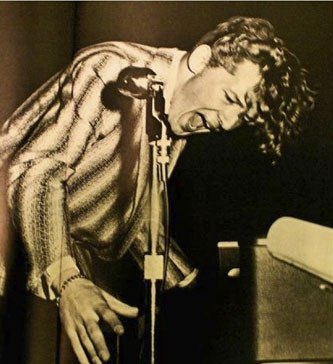 1956: 19-year old Jerry Lee Lewis arrives at Sun Records in Memphis to audition for a recording contract. Jerry is disappointed to discover label owner Sam Phillips in on vacation in Florida. Engineer Jack Clement has Lewis cut a demo recording anyway.
1956: 19-year old Jerry Lee Lewis arrives at Sun Records in Memphis to audition for a recording contract. Jerry is disappointed to discover label owner Sam Phillips in on vacation in Florida. Engineer Jack Clement has Lewis cut a demo recording anyway.
When Phillips returns from vacation, he likes what he hears and hires Jerry to work as a singer and session musician.
This Day in Rock History - August 31st
 1974: John Lennon tells a U.S. court that he believes the Nixon administration is trying to get him deported because of his anti-war views. He also claims the U.S. government is tapping his phone.
1974: John Lennon tells a U.S. court that he believes the Nixon administration is trying to get him deported because of his anti-war views. He also claims the U.S. government is tapping his phone.
He is later proved to be correct on both counts.
This Day in Rock History - August 30th


1990: Canadian born singer/composer Paul Anka finally becomes a U.S. citizen. During the ceremony in Las Vegas, Anka’s car is towed away for being parked illegally.
The Essential Boomer Album Collection - Part 6
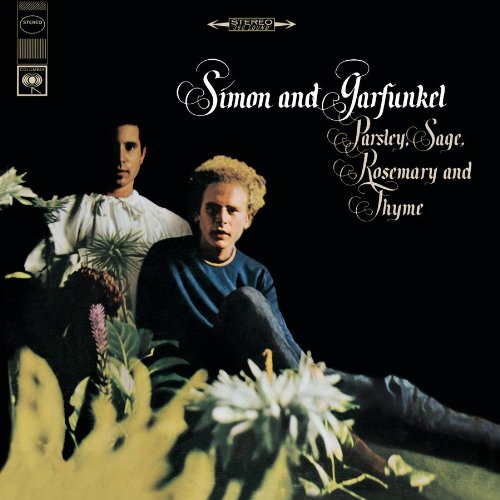 Parsley, Sage, Rosemary & Thyme (1966)
Parsley, Sage, Rosemary & Thyme (1966)
Its title sounded more like a cookbook than a record album, but Parsley, Sage, Rosemary & Thyme capped a spectacularly rapid rise to superstardom for a duo who had been trying to make it in the music business since 1957.
It was technically Simon & Garfunkel’s third studio album, but it was really the first where they were allowed to exercise creative control.
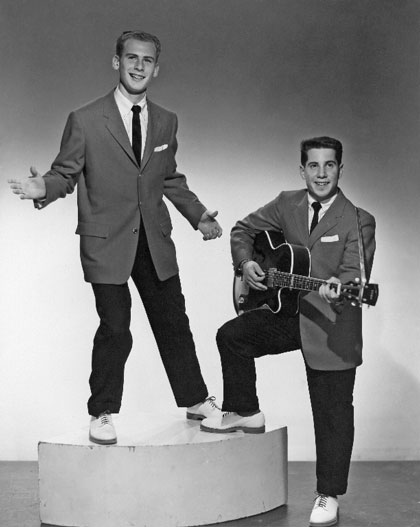 Paul Simon and Art Garfunkel had been friends in school. Their first efforts at recording had been as a rock and roll duo who called themselves Tom & Jerry. They actually had a small regional hit with “Little Schoolgirl” in 1957. The 1958 follow-up single bombed, and the boys soon gave up rock, turning instead to the emerging folk music scene.
Paul Simon and Art Garfunkel had been friends in school. Their first efforts at recording had been as a rock and roll duo who called themselves Tom & Jerry. They actually had a small regional hit with “Little Schoolgirl” in 1957. The 1958 follow-up single bombed, and the boys soon gave up rock, turning instead to the emerging folk music scene.
Using their own names, they recorded an album of folk tunes for Columbia Records called Wednesday Morning, 3 A.M. That bombed, too. So Simon and Garfunkel went their separate ways. Simon took off for London while Artie remained stateside.
Meanwhile, something called “folk-rock” was taking over the music business. It began when Bob Dylan plugged in an electric guitar. But it went super-nova when the West Coast rock band the Byrds took a rock arrangement of Dylan’s “Mr. Tambourine Man” to the top of the charts. Both Dylan and the Byrds were on Columbia Records.
In a bid to corner the “folk-rock” market, Columbia (without Simon and Garfunkel’s permission or even knowledge) took a track from Wednesday Morning, 3 A.M. and added drums and electric bass. Like “Tambourine Man" before it, “The Sounds of Silence” raced up the charts!
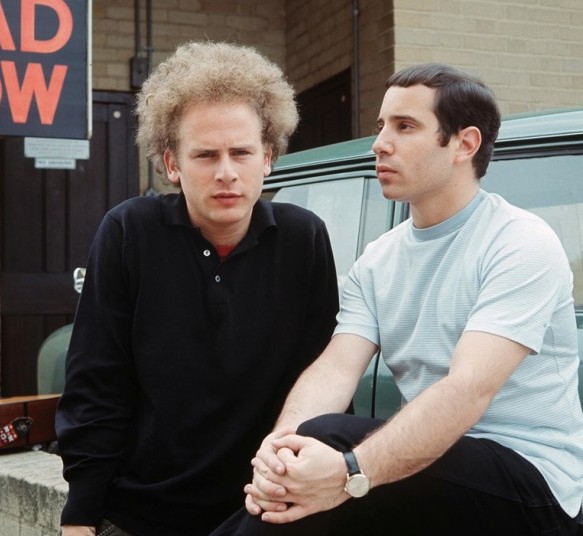 Quickly reunited, Columbia threw Simon & Garfunkel into the studio to come up with an album that reflected their new status as the darlings of “folk rock.”
Quickly reunited, Columbia threw Simon & Garfunkel into the studio to come up with an album that reflected their new status as the darlings of “folk rock.”
In the UK, Simon had recorded a solo album for release in that country only, called The Paul Simon Songbook. Five of those songs were quickly reworked (“I Am a Rock,” “Leaves That Turn Green,” “April Come She Will,” “A Most Peculiar Man,” and “Kathy’s Song”). The resulting album, The Sounds of Silence, did well but not spectacularly. It peaked at #21 on Billboard’s album chart.
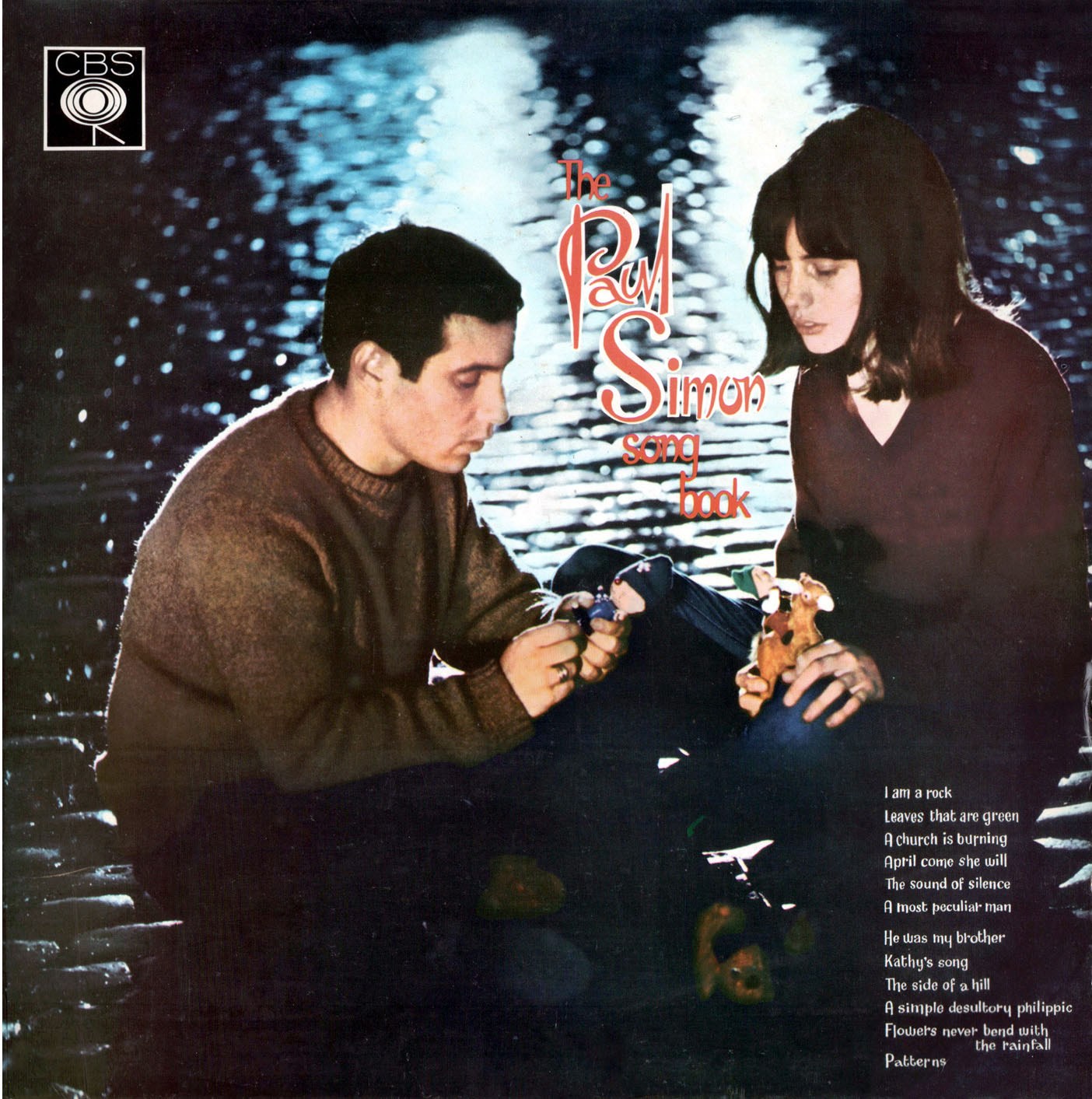 For their third album, Simon and Garfunkel were determined to take more time. It took them three months and cost $30,000 (a long time and astronomical sum of money in the music business back then). But the result was one of the first albums from a group not named the Beatles that demanded to be listened to as a single cohesive musical work, not simply a collection of a couple of singles and some filler. Parsley, Sage, Rosemary & Thyme peaked at #4 on the album charts and has since gone triple platinum. It was also named to Rolling Stones’ “Top 500 Albums of All Time.” It firmly established Simon & Garfunkel as rock royalty.
For their third album, Simon and Garfunkel were determined to take more time. It took them three months and cost $30,000 (a long time and astronomical sum of money in the music business back then). But the result was one of the first albums from a group not named the Beatles that demanded to be listened to as a single cohesive musical work, not simply a collection of a couple of singles and some filler. Parsley, Sage, Rosemary & Thyme peaked at #4 on the album charts and has since gone triple platinum. It was also named to Rolling Stones’ “Top 500 Albums of All Time.” It firmly established Simon & Garfunkel as rock royalty.
How many of us remember that the album title is NOT the name of the first track but simply a lyric from that song? “Scarborough Fair” is an old English folk ballad (traced back as far as 1670) that had become something of a staple on the folk music circuit of the day. But both Paul and Art worked on rearranging the song, adding a counter melody that included lyrics cribbed from another song Simon cut in the UK called “The Side of a Hill.” The result is a rock classic that is uniquely S&G’s own.
What is also not remembered is that the song was not a hit when the album was first released in the fall of 1966. It only hit the pop charts two years later when it was featured as part of the soundtrack to Mike Nichols’ film, The Graduate.
Two of the songs on Parsley, Sage, Rosemary & Thyme did become hits. Those were “Homeward Bound” and “The Dangling Conversation.” A third song, “The 59th Street Bridge Song (Feelin’ Groovy),” also hit the Top 20 when it was covered by Harper’s Bizarre.
The album is a great example of the influence folk was having as many of the younger members of that movement (Simon, John Phillips, John Sebastian, etc.) were migrating to rock. The folkies brought with them an interest in social movements and the left-wing political causes of the day.
On Parsley, Sage, Rosemary & Thyme, Paul Simon hilariously sends up the entire “protest song” fad and Bob Dylan himself with “A Simple Desultory Philippic (Or How I Was Robert McNamara’d into Submission)” (an updated version of another song from his UK LP). He then turned around and closed the album with a very serious piece of musical protest, "Silent Night/7 O' Clock News." Paul & Artie sang the traditional Christmas carol while a horrific newscast (featuring actual stories of the day read by veteran L.A. radio announcer Charlie O’Donnell) grows continually louder.
 Long a fan favorite song, Artie sings “For Emily, Wherever I May Find Her” all by himself and has never sounded more angelic. The album also features two more songs pulled from the Simon solo UK album: “Flowers Never Bend with the Rainfall” and “Patterns”.
Long a fan favorite song, Artie sings “For Emily, Wherever I May Find Her” all by himself and has never sounded more angelic. The album also features two more songs pulled from the Simon solo UK album: “Flowers Never Bend with the Rainfall” and “Patterns”.
Hard to believe because of their enormous success and influence, but Simon & Garfunkel were destined to record only two more studio albums.
Despite the very mid-sixties’ touches, Parsley, Sage, Rosemary & Thyme has aged very well and remains an essential part of any Boomer’s music collection.
Gun Crazy (1950)
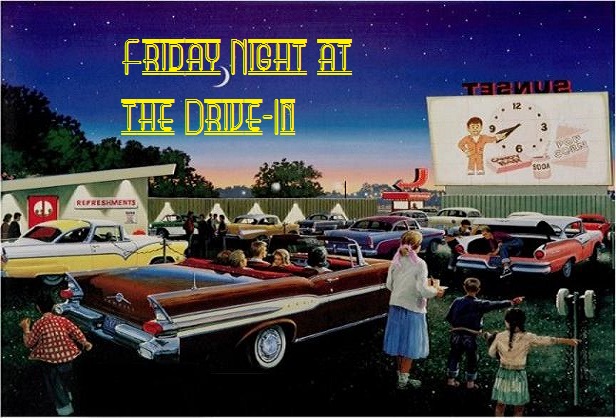 If you love gangsters movies and haven’t seen this film, stop what you’re doing and buy, rent, stream or in any way possible see this movie!
If you love gangsters movies and haven’t seen this film, stop what you’re doing and buy, rent, stream or in any way possible see this movie!
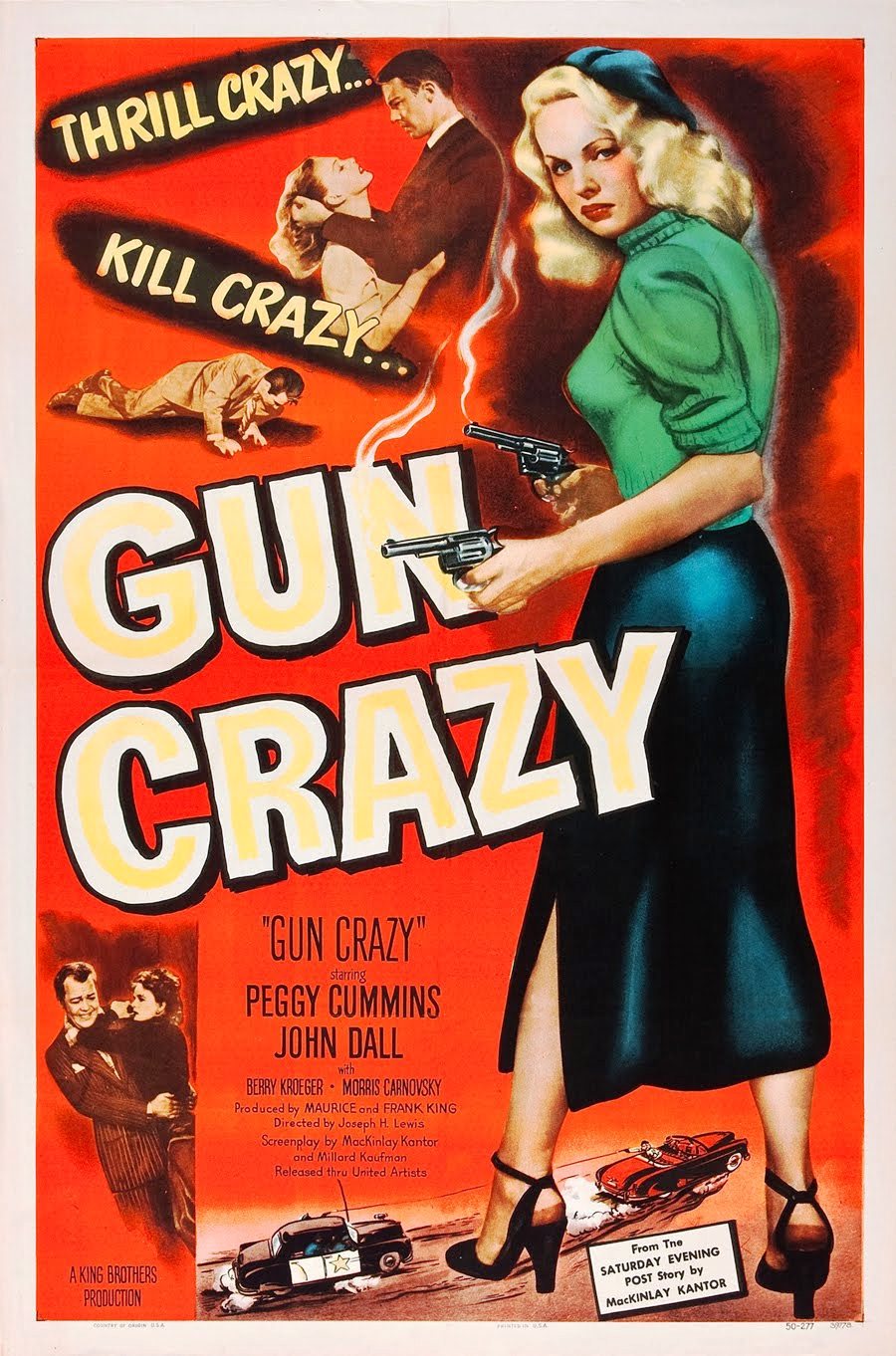 If you saw the Oscar-nominated Trumbo (2015) and are curious about the films Douglas Trumbo wrote while blacklisted, see this movie!
If you saw the Oscar-nominated Trumbo (2015) and are curious about the films Douglas Trumbo wrote while blacklisted, see this movie!
Gun Crazy may be the greatest film most people have never heard of!
Quick recap if you didn’t see Trumbo: During the days of the Hollywood blacklist, screen writer Douglas Trumbo (Spartacus) was reduced to working for a low-rent b-movie outfit run by Frank and Maurice King (John Goodman plays Frank King in the film). Trumbo’s work on Gun Crazy had to be credited to his friend Millard Kaufman.
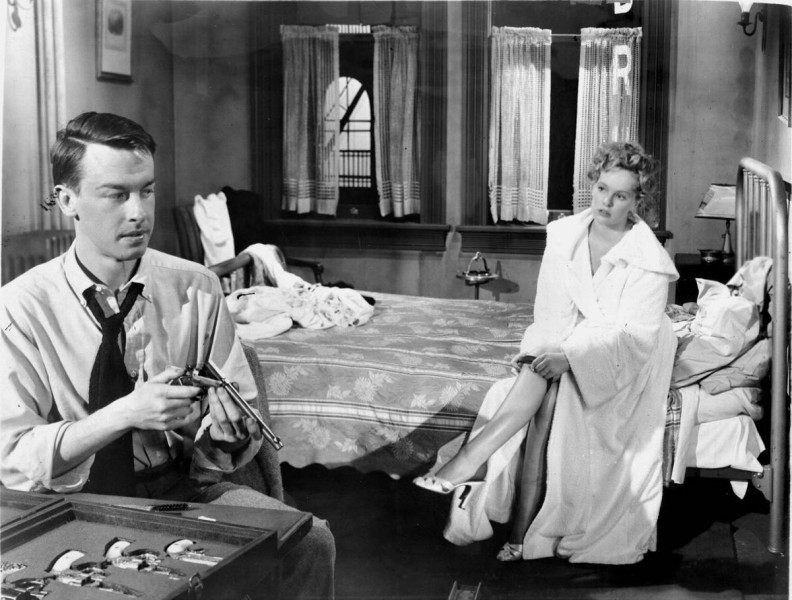 Gun Crazy is one of the cheaply made pot-boilers the King Brothers specialized in. Yet Trumbo’s script, combined with Joseph Lewis’ direction and the acting of the leads (John Dall and especially Peggy Cummins) turn this into one of the best and most influential gangster films of the post-WWII era.
Gun Crazy is one of the cheaply made pot-boilers the King Brothers specialized in. Yet Trumbo’s script, combined with Joseph Lewis’ direction and the acting of the leads (John Dall and especially Peggy Cummins) turn this into one of the best and most influential gangster films of the post-WWII era.
The tale is simplicity in itself. Dall plays Bart Tare, a young man with a most unhealthy obsession with firearms (Calling, Dr. Freud!). Despite his love of guns, he also has a real aversion to using them to kill or harm people.
Tare meets his match in a side show sharpshooter named Annie Laurie Starr (Cummins), who shares Tare’s gun love, but not his ethics.
Before long, the duo leave the carnival for a wild interstate crime spree you just know is not going to end well.
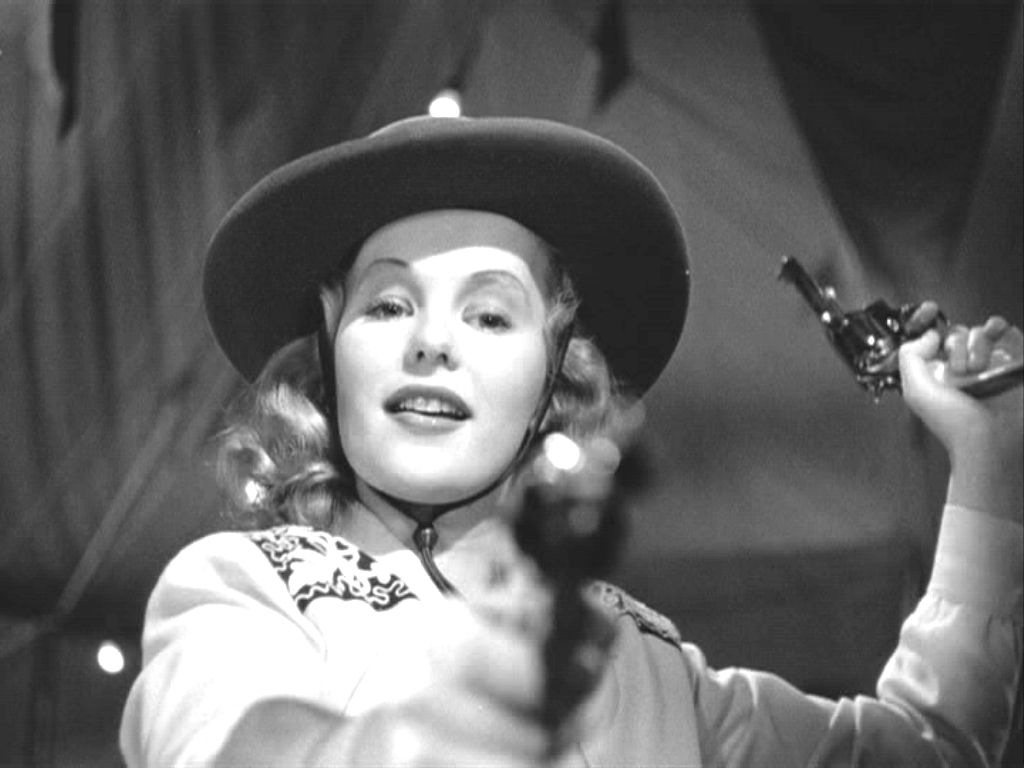 Why Peggy Cummins didn't have a better career in Hollywood remains a mystery. In Gun Crazy, she is smokin’ hot and her acting is several notches above her co-star. Cummins eventually returned to her native England where she had a modestly successful career. Hollywood’s loss.
Why Peggy Cummins didn't have a better career in Hollywood remains a mystery. In Gun Crazy, she is smokin’ hot and her acting is several notches above her co-star. Cummins eventually returned to her native England where she had a modestly successful career. Hollywood’s loss.
Watch closely at the beginning, you will also see a very young Russ Tamblyn (billed as “Rusty Tamblyn”) make an appearance as the young Bart Tare.
Also pay attention to a stunning bank robbery scene. This scene was shot in one continuous take with a camera mounted in the back seat of the robbery vehicle. We watch as the car pulls up to the bank, a patrolman is distracted and then knocked out. We wait while Tare goes into the bank. Then we watch as he returns for the getaway. To add to the realism of the scene, the director instructed his actors to improvise their dialog.
While the film was consigned to grindhouse circuit in both its initial release and a subsequent re-release (where the film was re-titled Deadly Is the Female), it has continued to gain in stature and notoriety through the years.
In 1998, Gun Crazy was selected for preservation in the United States National Film Registry by the Library of Congress as being "culturally, historically, or aesthetically significant."
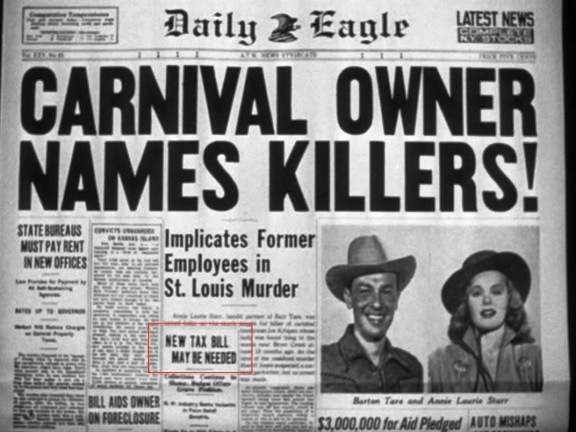 The film has also been nominated for inclusion in several “best” lists of the American Film Institute including:
The film has also been nominated for inclusion in several “best” lists of the American Film Institute including:
- AFI 100 Years… 100 Movies
- AFI 100 Years… 100 Thrills
- AFI 100 Years… 100 Passions
- AFI 100 Years… 100 Movie Quotes
- AFI’s 10 Top 10: Gangster Films.
Gun Crazy also had a huge impact on both French New Wave films and Arthur Penn & Warren Beatty when they teamed to make another film about a pair of gun crazy lovers, Bonnie and Clyde.
The time of the blacklist is one of the worst episodes in movie history and certainly one we never hope to see again. But without it, we’d never have had Gun Crazy.
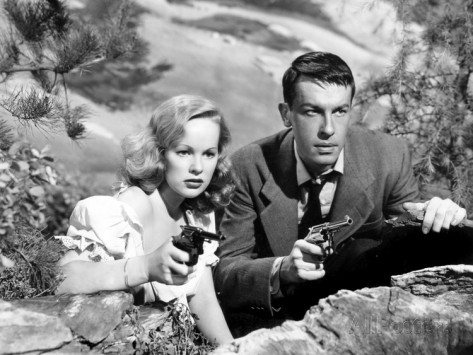
As Seen on TV: Silly Putty
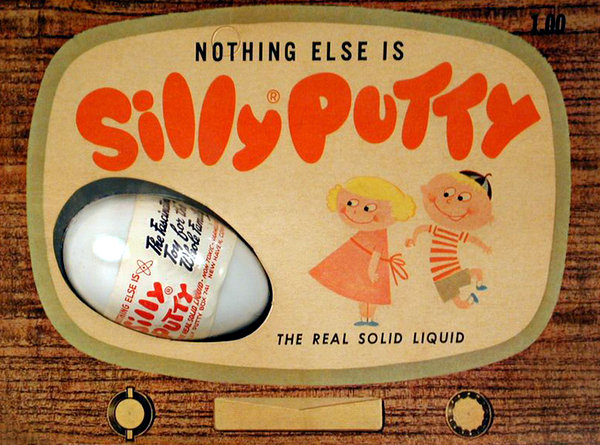 Is there a Baby Boomer who did not own at least one egg of Silly Putty at some point in their childhood?
Is there a Baby Boomer who did not own at least one egg of Silly Putty at some point in their childhood?
Much more than a fad, the stuff still sells over six million eggs a year!
And just think, we have the Japanese of World War II to thank for it!
You see, in the early months of the Second World War, the Japanese quickly invaded and took over the major rubber-producing countries. Rubber was vital to the American war effort. So in addition to rationing rubber back home, the search was on to find a rubber substitute.
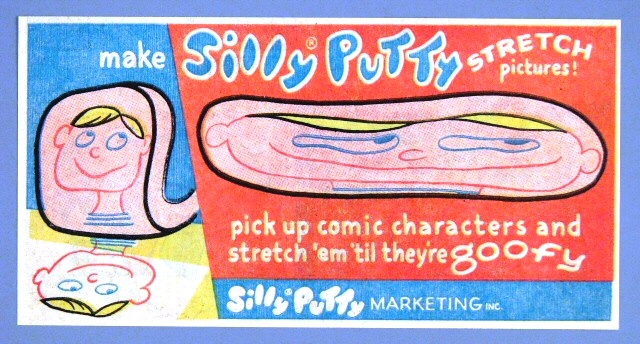 Credit for the substance goes to Earl Warrick at Dow Chemical as well as James Wright at General Electric. Working independently, these gentlemen added boric acid to silicone oil. A few other minor ingredients were added and viola – Silly Putty! Only neither company called it that. In fact, both companies could see no use for the stuff. While the stuff bounced like a ball, could stretch more that rubber and snapped apart if you smashed it hard, it just wasn’t stable enough to replace rubber. The stuff tended to form a puddle if left alone long enough.
Credit for the substance goes to Earl Warrick at Dow Chemical as well as James Wright at General Electric. Working independently, these gentlemen added boric acid to silicone oil. A few other minor ingredients were added and viola – Silly Putty! Only neither company called it that. In fact, both companies could see no use for the stuff. While the stuff bounced like a ball, could stretch more that rubber and snapped apart if you smashed it hard, it just wasn’t stable enough to replace rubber. The stuff tended to form a puddle if left alone long enough.
So Wright patented the stuff, but nothing came of it. Until 1949.
For reasons lost to history, a toy shop owner Ruth Fallgatter came across the substance. She thought she might be able to sell it. She called a marketing consultant named Peter Hodgson. Together they named it Silly Putty, put it in a clear plastic case and onto the shelves of Ruth’s shop. The stuff sold pretty well. But Ruth saw it as a limited fad and really wasn’t interested in trying to sell a second batch.
 So Hodgson went out on his own. He borrowed $147 to buy a batch of Silly Putty and then had his really genius idea. Because the stuff tended to melt went left alone for long periods of time, Hodgson hit on the idea of packaging Silly Putty inside plastic eggs.
So Hodgson went out on his own. He borrowed $147 to buy a batch of Silly Putty and then had his really genius idea. Because the stuff tended to melt went left alone for long periods of time, Hodgson hit on the idea of packaging Silly Putty inside plastic eggs.
At first, sales were slow, but then he convinced New Yorker magazine to run an article about it. He sold 250,000 eggs of Silly Putty at $1 an egg in three days.
In 1955, Silly Putty became one of the first toys to be sold via television when Hodgson bought time on The Howdy Doody Show.
Pete Hodgson passed away in 1976. One year later, the rights to the toy where acquired by Binney & Smith, the makers of Crayola crayons.
Today, Silly Putty is sold in countries all over the world. It’s been up in space with the astronauts. And in 2001, it was inducted into the National Toy Hall of Fame.
Oh, and if you get some caught in you hair or it melts all over the sofa, the manufacturer recommends using alcohol. No, not the kind you drink. The kind you should rub on the Silly Putty.
Return to Mayberry
It's been awhile since we looked in on our friends in Mayberry. Here's how they're doing:
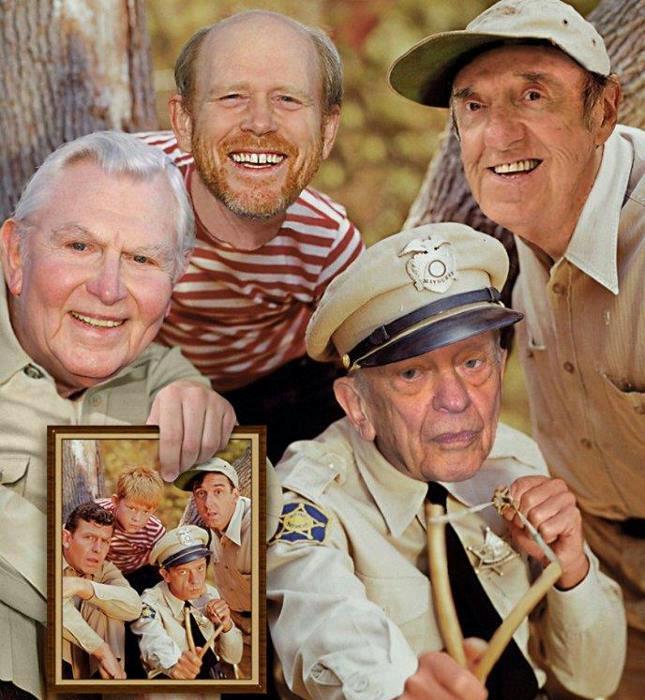
This Day in Rock History - August 29th
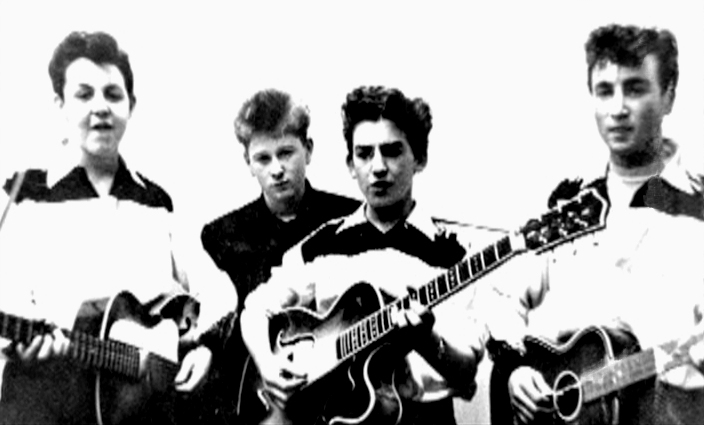 1959: The Quarrymen consisting of John Lennon, Paul McCartney, George Harrison and Ken Brown, play at the opening of the Casbah Coffee Club in Liverpool. The club is located in the basement of private home owned by Mona Best. She has a son named Pete, the Quarrymen still need a drummer.
1959: The Quarrymen consisting of John Lennon, Paul McCartney, George Harrison and Ken Brown, play at the opening of the Casbah Coffee Club in Liverpool. The club is located in the basement of private home owned by Mona Best. She has a son named Pete, the Quarrymen still need a drummer.
Wonder what happens next?
This Day in Rock History - August 28th

2005: Classic rock & roll bad boy, Art Garfunkel is charged with marijuana possession for the 2nd time in two years when a joint is found in the ashtray of his car.
Pop Up Player
Latest Posts–Health & Wellness
-
Are You Hot or Cold When It Comes to Pain Relief?
There have long been two schools of thought regarding bodily pain. Some tell you to put ice on it. Some tell you to use heat. Which is better? That depends. According to this most recent…
-
Tips for Better Sleep
As we grow older, many of us begin experiencing trouble sleeping through the night. If you find yourself waking up in the dark multiple times during the night, try these “sleep hacks” to getting a…
-
Vitamin C to See
Research indicates that vitamin C can reduce the risk of developing cataracts. But don’t start popping pills. The study also should that this benefit only comes from dietary vitamin C. In others words, you need…
-
To Vape or Not to Vape
Vaping – the practice of smoking using an “electronic cigarette” has been touted as a safe alternative smoking, but is it really? If you are a current tobacco smoker, the answer is – it’s safer…
-
Beating the 4 AM Blues
Many us find sleeping all the way through the night more of a challenge than we did a few years ago. Here are some of the most common cause…and cures! Eating Too Close to Bedtime…
-
The Eyes Have It - Especially as We Age
Eye problems, that is. As we age, there are two very common problems with our eyes. Dry Eye – This problem is amplified by our near constant use of screens (TV and computer). Staring at…


